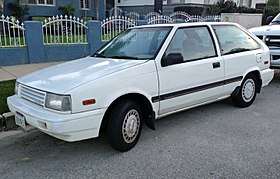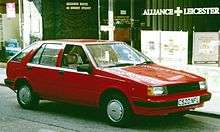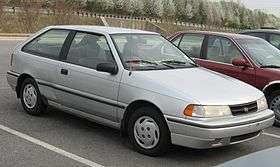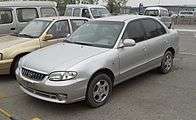Hyundai Excel
| Hyundai Excel | |
|---|---|
_Sprint_3-door_hatchback_(2015-07-06)_01.jpg) | |
| Overview | |
| Manufacturer | Hyundai |
| Also called |
Hyundai Pony Hyundai Pony Excel (X1 hatchback in South Korea) Hyundai Presto (X1 sedan in South Korea) Mitsubishi Precis Hyundai X2 (UK)[1] |
| Production | 1985–2000 |
| Body and chassis | |
| Class | Subcompact car |
| Layout | FF layout |
| Related |
Hyundai Scoupe Mitsubishi Mirage |
| Chronology | |
| Predecessor | Hyundai Pony |
| Successor | Hyundai Accent |
The Hyundai Excel (Hangul: 현대 엑셀), also known as the Hyundai Pony, Hyundai Presto, Mitsubishi Precis and Hyundai X2, is an automobile which was produced by Hyundai Motor Company from 1985 to 2000. It was the first front-wheel drive car produced by the South Korean manufacturer. The Excel range replaced the rear wheel drive Hyundai Pony.
Background
As with the original 1974 Pony, the Excel was designed by Giorgetto Giugiaro. The Excel was available in three- or five-door hatchback and four-door sedan models.[2] The Excel was the first Hyundai car to be exported to the United States.
The Excel was available with either a manual or automatic transmission mated to a four-cylinder engine aspirated by a carburetor or fuel injection system, depending on market and model year.
Originally, the Excel was supposed to be replaced by the Elantra in 1990, but it ended up being sold for four more years until being replaced by the Hyundai Accent in the model year 1995. From 1990, there was a coupé variant called the Hyundai Scoupe, which was replaced by the Hyundai Coupe in 1996.
Names
Some markets, including Europe, had the Excel branded as the Hyundai Pony, although it is not directly related to the early 1980s rear wheel drive Pony. In South Korea the hatchback version was known as Hyundai Pony Excel, and the sedan version was known as Hyundai Presto.
The Excel was also sold in the United States by Mitsubishi Motors from 1987 to 1994 as the badge engineered Mitsubishi Precis. Available as either a 3- or 5-door hatchback, the Precis remained in the Mitsubishi range as a "price leader," slotted below the Mirage until it was discontinued in 1992.[3]
X1 (1985–1989)
| X1 (1985–1989) | |
|---|---|
 1989 Hyundai Excel GL 3-door (USA) | |
| Overview | |
| Production | 1985–1989 |
| Assembly | Ulsan, South Korea |
| Designer | Giorgetto Giugiaro |
| Body and chassis | |
| Body style |
3-door hatchback 5-door hatchback 4-door sedan |
| Powertrain | |
| Engine | 1.5 L 68 hp I4 (gasoline) |
| Transmission |
4-speed manual 5-speed manual 3-speed automatic |
| Dimensions | |
| Wheelbase | 93.7 in (2,380 mm) |
| Length |
160.9 in (4,087 mm) (2-door) 168 in (4,267 mm) (4-door) |
| Width | 63.1 in (1,603 mm) |
| Height | 54.1 in (1,374 mm) |
The Excel was introduced as a replacement for the Hyundai Pony. In the United States it was the company's first and only model, but thanks to a price of $4,995 USD and being voted 'Best Product #10' by Fortune magazine, it set records for a first-year import by selling 168,882 units, helping push the company's cumulative production past one million by 1986.[4] Similar sales success was replicated in Australia, where it was priced at A$9,990.

_(8038131673).jpg)
Versions available were:
North America
- 1.5 base
- 1.5 GL
- 1.5 GLS (5-door and 4-door only)
- 1.5 GS (3-door only)
Australia
- 1.5 L
- 1.5 GL
- 1.5 GLS
- 1.5 GT
United Kingdom
- 1300 L/Sonnet
- 1300 GLS
- 1500 GL
- 1500 GLS
X2 (1990–1995)
| X2 (1989–95) | |
|---|---|
 | |
| Overview | |
| Also called | Hyundai X2 (UK)[1] |
| Production |
1989–1995 1995–1998 (Philippines) |
| Assembly | Ulsan, South Korea |
| Body and chassis | |
| Body style |
3-door hatchback 5-door hatchback 4-door sedan 3-door panel van[5] |
| Powertrain | |
| Engine |
1.3 L 4G13 I4 1.5 L 81 hp (60 kW) I4 |
| Transmission |
4-speed manual 5-speed manual 3-speed automatic 4-speed automatic |
| Dimensions | |
| Wheelbase | 93.8 in (2,383 mm) |
| Length |
1990–91 & 1993–94 2-Door Hatchback: 161.4 in (4,100 mm) 1990–91 & 1993–94 5-Door Hatchback: 168.3 in (4,275 mm) 1992 Sedan: 168.6 in (4,282 mm) 1992 Hatchback: 161.7 in (4,107 mm) |
| Width |
1990–91 & 1993–94: 63.3 in (1,608 mm) 1992: 63.1 in (1,603 mm) |
| Height |
1993–94: 54.5 in (1,384 mm) 1992: 51.4 in (1,306 mm) 1990: 51.6 in (1,311 mm) |
The second-generation Excel was given a facelift and slightly enlarged from 1990 onwards, while its engine adopted multi-point fuel injection, and a new 4-speed overdrive automatic transmission was offered. It was sold in CX, LX and CXL trim levels in South Korea. The South Korean (home market) range was:
- 1.3 CX (3-door hatchback, 5-door hatchback, 4-door sedan)
- 1.3 LX (3-door hatchback, 5-door hatchback, 4-door sedan)
- 1.5 CX (3-door hatchback, 5-door hatchback, 4-door sedan)
- 1.5 LX (5-door hatchback, 4-door saloon)
- 1.5 CXL (5-door hatchback, 4-door saloon).
The Excel was marketed in Eurasia as the Hyundai Pony or Pony X2 (X2 representing second generation). In the United Kingdom and some parts of Europe, versions available were:
- 1.3 S (3-door hatchback, 5-door hatchback)
- 1.3 Sonnet (3-door hatchback) – replaced 1.3 S base model
- 1.3 LS (3-door hatchback, 5-door hatchback, 4-door sedan)
- 1.5 GSi (5-door hatchback, 4-door sedan)
However, some European markets did not get the 1.3 version and the range was:
- 1.5 L (3-door)
- 1.5 LE (3-door)
- 1.5 GL (3-door hatchback, 5-door hatchback)
- 1.5 LS (3-door hatchback, 5-door hatchback, 4-door sedan)
- 1.5 GS (3-door hatchback, 5-door hatchback, 4-door sedan)
- 1.5 GT (3-door hatchback, 5-door hatchback) – note, not all markets got this version
- 1.5 GLS (3-door hatchback, 5-door hatchback, 4-door sedan)
From 1991, the 1.5 versions were badged 1.5i to denote fuel injection.
All models sold in North America had the 1.5-liter engine, with automatic transmission as a freestanding option for any model. The lineup available at U.S. Hyundai dealers was;
- Base (3-door hatchback, 4 door sedan)
- GL (3-door hatchback, 4 door sedan, 5 door hatchback in 1990 only)
- GLS (3-door hatchback, 4 door sedan)
- GS (3-door hatchback)
The 5 door model may have been available in Canada for a longer period and in a wider variety of trims. The Mitsubishi Precis came as a 3-door only, in trim levels equivalent to the base and GL Hyundai-branded cars.
_Sprint_3-door_hatchback_(2015-11-13)_02.jpg) 1991-1994 Hyundai Excel (X2) Sprint 3-door hatchback (Australia)
1991-1994 Hyundai Excel (X2) Sprint 3-door hatchback (Australia)_LS_5-door_hatchback_02.jpg) 1991–1994 Hyundai Excel (X2) LS 5-door hatchback (Australia)
1991–1994 Hyundai Excel (X2) LS 5-door hatchback (Australia)_LS_sedan_03.jpg) 1991-1994 Hyundai Excel (X2) LS sedan (Australia)
1991-1994 Hyundai Excel (X2) LS sedan (Australia)
The 1.3 model and the Mitsubishi Colt also share the same engine and gearbox.
Hyundai launched the Excel in Thailand in the early 1990s. The lineup consisted of:
- 1.3 Base (Manual and Automatic)
- 1.3 LS (Manual and Automatic)
- 1.5 LS (Manual)
- 1.5 GLS (Manual and Automatic, with a fuel injected version (GLSi) also available)
Third Generation (X3; 1994–2000)
| Third generation (X3) | |
|---|---|
_LX_sedan_(2010-07-13)_01.jpg) | |
| Overview | |
| Also called |
Hyundai Accent Verna (Venezuela) Hyundai Excel Hyundai Pony (France) Bimantara Cakra (Indonesia) Kia Qianlima (China)[6][7][8] Dodge Brisa (Venezuela) |
| Production |
1994–2000 (South Korea) 1995–2006 (Egypt) 2002–2006 (China) |
| Assembly |
Ulsan, South Korea Cairo, Egypt (Ghabbour Group)[9] İzmit, Turkey (Hyundai Assan)[10] Gaborone, Botswana (TMBC)[11] Barcelona, Venezuela (MMC Automoriz) Bekasi, Indonesia (Hyundai Indonesia)[12] Yancheng, Jiangsu (Dongfeng Yueda Kia) |
| Body and chassis | |
| Body style |
4-door sedan 3-door hatchback 5-door hatchback 2-door coupé |
| Powertrain | |
| Engine |
1.3 L G4EA (gasoline) (China) 1.3 L G4EH I4 (gasoline) 1.5 L G4EK I4 (gasoline) 1.5 L G4FK I4 (gasoline) 1.6 L G4ED I4 engine |
| Transmission |
5-speed M5AF3 manual 4-speed A4AF2 automatic |
| Dimensions | |
| Wheelbase | 2,400 mm (94.5 in) |
| Length |
4,100 mm (161.4 in) (hatchback) 4,117 mm (162.1 in) (sedan) |
| Width | 1,620 mm (63.8 in) |
| Height |
1,395 mm (54.9 in) 1,410 mm (55.5 in) (Kia Qianlima) |
| Curb weight | 2,101–2,150 lb (953–975 kg) |
The Hyundai Excel (X3) was introduced as the new model for the Excel in 1994 for the 1995 model year. It continued to be called Dodge Brisa in Venezuela or Hyundai Excel in some markets, such as the Netherlands, Belgium and Australia. In France, it was called the Hyundai Pony and in China, it was called the Kia Qianlima.
Australian cars were released in November 1994 available in Sprint and GX trims (three-door hatchback) or LX and GLX trims (four-door sedan and five-door hatchback). The upper-specification models (GX and GLX) had full cloth interior (as opposed to vinyl seat backings), height and lumbar support adjustments on the driver's seat, four-speaker sound system (instead of two), passenger vanity mirror, a tachometer, and power antenna as standard. GX three-doors also had a standard rear spoiler, while power steering was standard on all but the Sprint. There were also some special editions—the Classique sedan in 1996 with anti-lock brakes and the Sportz in 1999 and 2000 with alloy wheels and a rear spoiler. The overwhelming majority sold were the Sprint three-door, enticing buyers with free air-conditioning, driveaway pricing and from late 1998, standard power steering.
The facelift arrived in Australia in April 1997 with accompanying trim changes. The engine was a 1.5-liter G4EK SOHC unit with 91 hp (68 kW). From November 1997 onwards, this was upgraded to a twin cam (DOHC) G4FK version with 74 kW (99 hp) at 6000 rpm and torque of 134 N⋅m (99 lb⋅ft) at 4000 rpm. A double overhead cam (DOHC) engine was also available in America in the Accent GT but made a more-powerful 105 hp (78 kW) at 6000 rpm instead.[13] X3s with the DOHC engine are badged "Twin Cam".
In Australia, the X3 proved so popular (due to its reliability and low price[14][15][16]) that it was the third best-selling vehicle in the country in both 1996 and 1998. In the latter year, it achieved more than 44,000 sales (a 5.5% share of the total market), a record figure at the time, for an imported car. Between 1994 and 2000, some 200,000 X3s were sold in Australia, making it arguably the most successful imported vehicle in the country's history.
The Excel was sold in saloon (sedan), hatchback, and coupé form in the UK, with a choice of three engines for each: a 1.3 12v (85 hp), 1.5 12v (92 hp) and a 1.5 16v (105 hp) petrol. There was no diesel option. A GSi spec car was the top-specification Accent. The MVi-spec coupé version won particular praise for its handling agility in the UK. Although the Accent was cheap to buy and insure, its engines were quite thirsty; the 1.5-litre returned 33 mpg‑imp (8.6 L/100 km; 27 mpg‑US) average according to list figures.
In the US, although manuals exist for Accents before and after 1999, a manual for 1999 Hyundai Accent has not been published. Additionally, owners of the 1999 model were informed by their dealers that the power output of the 1.5-liter engine was in fact rated at 88 horsepower (66 kW).
In China, the Hyundai Excel was branded as the Kia Qianlima under Dongfeng Yueda Kia. It came with either a 1.3 or a 1.6 liter engine. Production ran from December 2002 until November 2006. It had similar styling to the regular Hyundai Excel until it was given a facelift in 2005 featuring a new grille and foglamps. Trim levels included the 1.3 DLX, 1.3L GL (Manual), 1.3L GL (Automatic), 1.6 GLS (Manual) and the 1.6 GLS (Automatic). The only body style available was the 4 door sedan.[17]
Safety
The 1998 Hyundai Excel was crash-tested by the European New Car Assessment Programme and showed rather poor performance, scoring only 4 points out of 16 for frontal impact.[18] The passenger compartment became unstable in the crash test.[18] It was determined that there was an unacceptable high risk of chest injury during side impact crash, as a result, the car would not meet the minimum legal requirement in 1999.[18] The Swedish insurance company, Folksam, rates the 1st-gen Accent as one of the safest cars in its weight class.[19]
Gallery
_Sprint_3-door_hatchback_(2015-07-14)_02.jpg) Pre-facelift Hyundai Excel 3-door, Australia
Pre-facelift Hyundai Excel 3-door, Australia_GLX_sedan_(2015-06-25)_02.jpg) Pre-facelift Hyundai Excel sedan, Australia
Pre-facelift Hyundai Excel sedan, Australia_GLX_sedan_(2010-07-05)_01.jpg) Facelift Hyundai Excel sedan, Australia
Facelift Hyundai Excel sedan, Australia_GLX_sedan_(2010-07-05)_02.jpg) Facelift Hyundai Excel sedan, Australia
Facelift Hyundai Excel sedan, Australia_Sprint_3-door_hatchback_(2015-06-03)_02.jpg) Facelift Hyundai Excel 3-door, Australia
Facelift Hyundai Excel 3-door, Australia Kia Qianlima (2003–2005)
Kia Qianlima (2003–2005) Kia Qianlima (2005–2006)
Kia Qianlima (2005–2006)
Footnotes
| Wikimedia Commons has media related to Hyundai Excel. |
- 1 2 HYUNDAI RANGE 1992-93 UK Mkt sales brochure - HCD-1 Scoupe Lantra X2 Sonata, www.ebay.ie, as archived at web.archive.org
- ↑ "Hyundai Excel The Car Directory". The-car-directory.com. 2007-12-27. Archived from the original on 2011-07-16. Retrieved 2010-11-21.
- ↑ "ConsumerGuide.com review". Auto.consumerguide.com. 2006-10-04. Archived from the original on 2008-09-05. Retrieved 2010-11-21.
- ↑ "Ssay it with SSUVs: Korea's SSangyong goes where the buyers are – sport/utility vehicles", Gwendolyn S. Knapp, Ward's Auto World, April, 1996 (FindArticles.com)
- ↑ Hyundai EXCEL van 1991 commercial 현대 엑셀 밴, www.youtube.com Retrieved 13 February 2017
- ↑ "2005 Kia Qianlima 06 - Gallery–China automotive news". Autonews.gasgoo.com. Retrieved 25 July 2010.
- ↑ "KIA Qianlima - 836570 - Product Catalog - Aikar Car Renting Co., Ltd. Jinjiang, Fujian - - DIYTrade.com Free Website". Icar.diytrade.com. Archived from the original on 10 July 2011. Retrieved 25 July 2010.
- ↑ "Dongfeng Yueda Kia. Dongfeng Yueda Kia in China". Car-cat.com. Retrieved 25 July 2010.
- ↑ "Hyundai. Hyundai in Egypt". Car-cat.com. Retrieved 25 July 2010.
- ↑ "Hyundai. Hyundai in Turkey". Car-cat.com. Retrieved 2 August 2010.
- ↑ "Hyundai plant revving up to make new inroads in S". Btimes.co.za. Retrieved 16 November 2010.
- ↑ "Company Profile". Hyundai Indonesia. Archived from the original on 18 August 2011.
- ↑ "Used 1996 Hyundai Accent GT Features & Specs". Edmunds. Retrieved 8 June 2015.
- ↑ "Hyundai Excel 1994". Drive.com.au. 28 November 2005. Retrieved 10 January 2015.
- ↑ "Used car review Hyundai Excel 1994-2000". Carsguide.com.au. 28 January 2009. Retrieved 10 January 2015.
- ↑ "Hyundai X3 Excel Hatch/Sedan (1994-2000)". Motoring.com.au. 1 April 2005. Retrieved 10 January 2015.
- ↑ "Kia Qianlima specs".
- 1 2 3 "1st generation LHD Hyundai Accent 4dr hatchback crash test by EuroNCAP". , euroncap.com
- ↑ "Tester & Goda råd: Hur säker är bilen (Bilguide) – Folksam". , folksam.se (in Swedish)
Hyundai road vehicle timeline, North American market, 1984–present | ||||||||||||||||||||||||||||||||||||
|---|---|---|---|---|---|---|---|---|---|---|---|---|---|---|---|---|---|---|---|---|---|---|---|---|---|---|---|---|---|---|---|---|---|---|---|---|
| Type | 1980s | 1990s | 2000s | 2010s | ||||||||||||||||||||||||||||||||
| 4 | 5 | 6 | 7 | 8 | 9 | 0 | 1 | 2 | 3 | 4 | 5 | 6 | 7 | 8 | 9 | 0 | 1 | 2 | 3 | 4 | 5 | 6 | 7 | 8 | 9 | 0 | 1 | 2 | 3 | 4 | 5 | 6 | 7 | 8 | 9 | |
| Subcompact | Excel | Excel | Accent | Accent | Accent | Accent | Accent | |||||||||||||||||||||||||||||
| Compact | Pony | Elantra | Elantra | Elantra | Elantra | Elantra | Elantra | |||||||||||||||||||||||||||||
| Elantra Touring | Elantra GT | Elantra GT | ||||||||||||||||||||||||||||||||||
| Sport compact | Scoupe | Tiburon | Tiburon | Veloster | Veloster | |||||||||||||||||||||||||||||||
| Mid-size | Ioniq | |||||||||||||||||||||||||||||||||||
| Stellar | Sonata | Sonata | Sonata | Sonata | Sonata | Sonata | Sonata | |||||||||||||||||||||||||||||
| XG | Azera | Azera | ||||||||||||||||||||||||||||||||||
| Coupé | Genesis Coupe | Genesis | ||||||||||||||||||||||||||||||||||
| Full-size | Genesis | Genesis | ||||||||||||||||||||||||||||||||||
| Equus | ||||||||||||||||||||||||||||||||||||
| Crossover SUV | Kona | |||||||||||||||||||||||||||||||||||
| Tucson | Tucson | Tucson | ||||||||||||||||||||||||||||||||||
| Santa Fe | Santa Fe | Santa Fe Sport | Santa Fe | |||||||||||||||||||||||||||||||||
| Veracruz | Santa Fe (LWB / XL) | |||||||||||||||||||||||||||||||||||
| Minivan | Entourage | |||||||||||||||||||||||||||||||||||